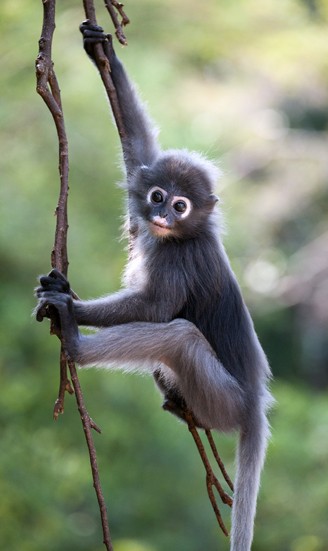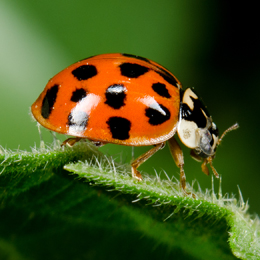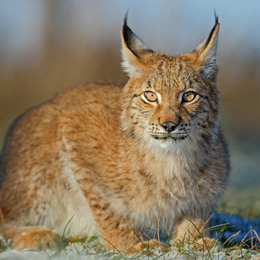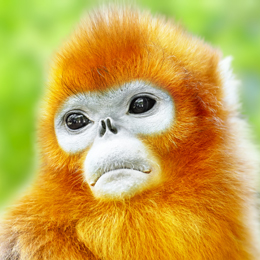Physical Description
The dusky leaf monkey with its cute and adorable looks is a primate species. They have large white colored circles around their eyes which give an appearance of a spectacle, which is the basis for its second funny name, the Spectacled Langur. This animal has also white colored patches of fur around its mouth and stomach while the rest of the fur has a gray to brownish color. The color of its fur varies along the 7 subspecies.
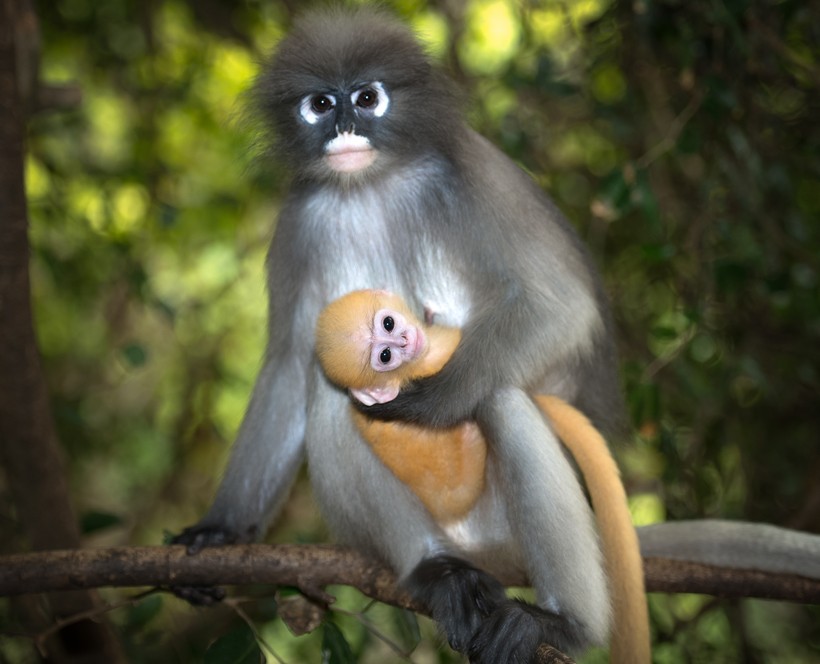
Newborn dusky leaf monkeys are orange or yellow in color
?
Image credits: Tratong/Shutterstock
The primate consists of short hind and forelimbs and has stronger fibula and femur compared to other species of langur. The tail is not adapted for holding and grasping and varies in length and fur coverage. The newborn dusky leaf monkeys are orange or yellow in color with a cute pink face. Within 6 months the color of the fur changes from orange to grey/brownish.
Size and Lifespans
The length of the body falls in the range of 42-61cm. Including its tail, they measure up to 50-85cm. Male monkeys are heavier and larger than their female counterparts. The average lifespan of a female Spectacled Langur under captivity is measured to be around 15.3 years. There are records of a Silvery Lutung (Trachypithecus cristatus), a langur species with a similar genus, that lived up to 31 years in captivity. It is hypothesized that the lifespan will be similar in the Trachypithecus obscurus species.
Anatomy
The distinctive feature of the dusky leaf monkey is its circular rings around its eyes which give an appearance of a spectacle. Another characteristic feature includes its buffy crown and creamy patch over the mouth. These monkeys are similar to other species in their anatomy and thereby do not have many unique adaptations.
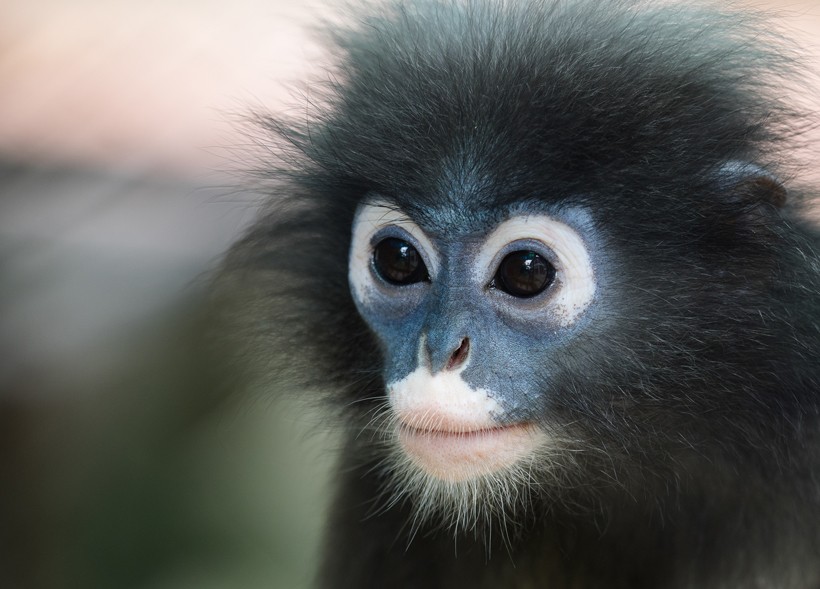
The name spectacled langur is due to the circular rings around its eyes
?
Image credits: ArtemBulkin/Shutterstock
One unique adaptation, however, involves the placement of its eyes. The fact that they are centered gives them a superior sensitivity on depth, which helps them to move around easily. Another adaptation concerns the position of its fingers and opposable thumbs. This enables the monkey in holding, grasping and supports smoothly locomotion. Instead for grasping, the tail of the dusky leaf monkey is used for balancing.
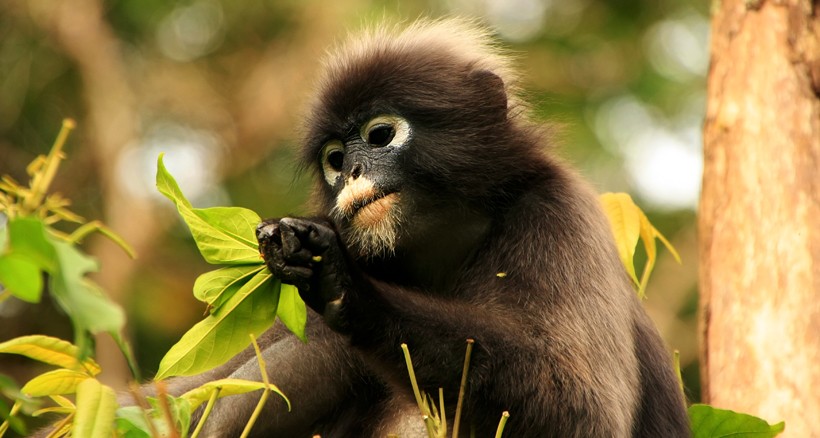
Dusky leaf monkeys are primarily foliovorous (a herbivore specialized in eating leaves)
?
Image credits: Don Mammoser/Shutterstock
These cute looking monkeys are arboreal and spend most of their time on trees. They move around by quadrupedal motion around the forest. Leaping and climbing movements are observed during their feeding activities.
Habitat
As dusky leaf monkeys are arboreal, they prefer dwelling on tall trees in dense forests. These monkeys prefer also various other habitats which include the coastal forests, riverine, urban forests, botanical gardens and parks.
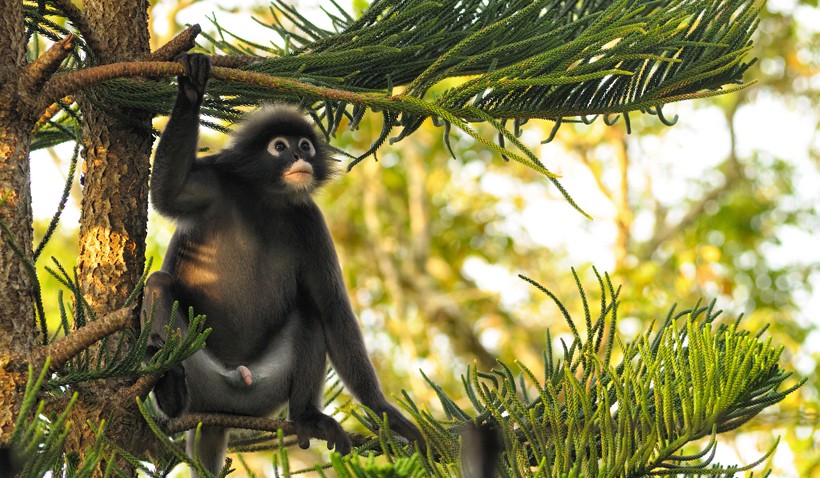
The monkeys prefer dwelling on tall trees
?
Image credits: Jordan Lye/Shutterstock
The Spectacled Langur is found majorly on Malay Peninsula which includes few parts of Thailand and Southern Burma. They also inhabit the islands of Penang, Langkawi and Perhentian Besar. Trachypithecus o. obscurus is mainly found in peninsular Malaysia while the other subspecies are found also scattered in Thailand and Burma.
Diet
Dusky leaf monkeys are primarily folivorous (a herbivore specialized in eating leaves) and thrive on consumption of flowers, shoots, seedlings, leaves and fruits. They can also consume unripe fruits and plant leaves.
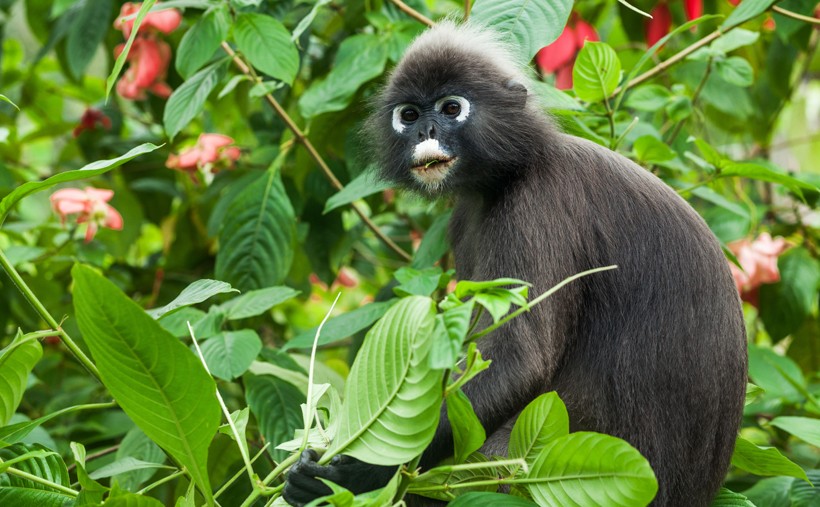
Their consumption consists of flowers, shoots, seedlings, leaves and fruits.
?
Image credits:
This is possible due to the presence of bacteria in the digestive system of the monkey which can break down cellulose. The dusky leaf monkey consumes 2 kg of food every day (while weighing only 5-9 Kg!).
These monkeys have a large stomach, which is divided into various sacs. The upper region of this stomach is involved in the fermentation of green leaves with the support of anaerobic cellulose-degrading bacteria. Besides the digestion of cellulose, these bacteria also facilitate the detoxification of the leaves. This bacterial digestion support is an added advantage for the dusty leaf monkeys, as they can feed on a wider variety of food.
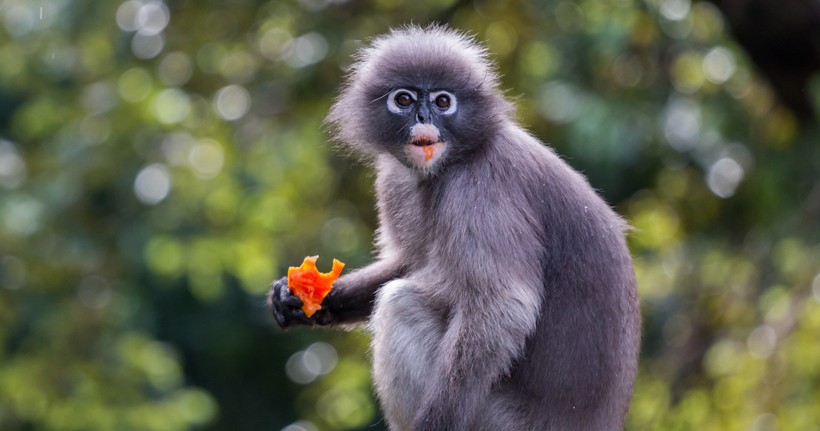
Spectacled langur eating a soft fruit
?
Image credits: Sompong Tokrajang/Shutterstock
In captivity, the monkeys are maintained on vegetables like sweet potato, cabbage, lettuce, carrots, green beans, along with various soft fruits.
Predators
As the monkeys dwell upon higher canopies of trees in the forest, they do not have many predators. But still they can be hunted by snakes, raptors and big carnivorous animals who are able to reach them.
One of the biggest known predators of these monkeys are humans, as they are used for food.
Behavior
The dusky leaf monkey is diurnal and highly active during day time. They prefer staying up in high canopies of tall trees and move around running, climbing and leaping on the branches of the trees. The monkey is known to have interactions within their own group.
The dusky leaf monkeys move around in groups with numbers ranging from 5 to 20 individuals. The groups consist of two or more adult females and only one male. Or more adult males being only one dominant. The dominant male adult is majorly responsible for keeping the group together, patrolling at boundaries of their territories and detecting predators around their territories. Solitary individuals are found in both the sexes. Under normal circumstances, the adult male submerges within the group but becomes aggressive when intruders are observed.
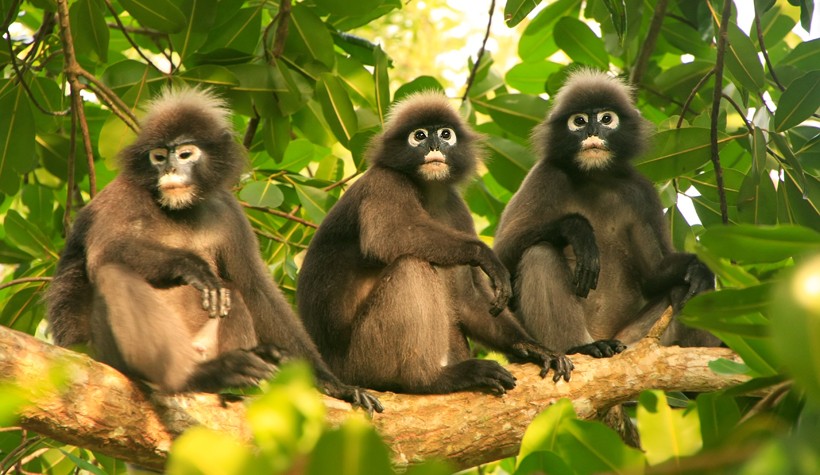
They move around in groups ranging from 5 to 20 individuals.
?
Image credits: Don Mammoser/Shutterstock
The Spectacled Langur shows minimal aggression and is rather focusing on reconciliation in case of aggression within the group. These docile and non-aggressive monkeys exhibit ventro-ventro hugging (belly-belly) during reconciliation. Among other, grooming is the most important first contact behavior observed within the group.
A large group of monkeys normally splits up in subgroups which usually consists of a juvenile and an adult female, but they tend to stay nearby at visual distances with each other. The Dusky Leaf Monkeys indulge each other with a social play which involves chasing, jumping over, wrestling and pulling each other’s tails.
The monkeys communicate through visual, tactile and vocal communication. The visual communication involves mounting, tongue flicks, and lunges. The majority of these visual communication involves signals when threats are observed but also to show domination under those circumstances. Mounting is the major way to show domination. When an individual wants to mount another who has its four limbs on the ground, he will raise its rump into the air. The mounter will stand behind the other with or without grasping the feet of recipient’s ankles.
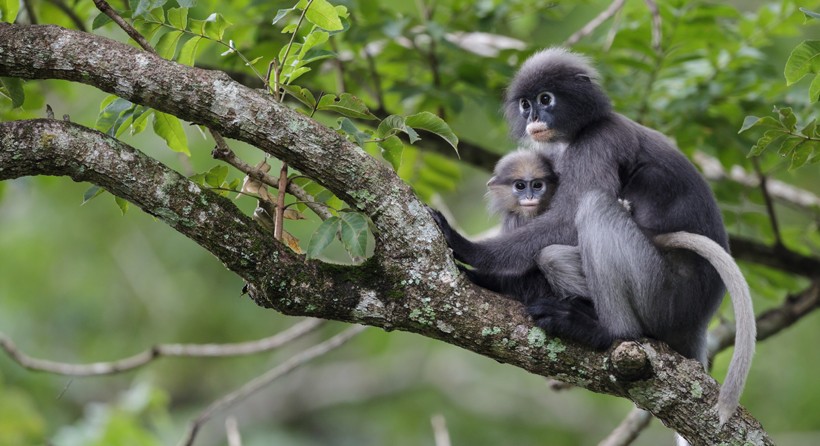
In around 70 days from birth, the infant gets more socialized and mingles with other group members.
?
Image credits: oolulu/Shutterstock
Another mode is tactile communication which involves social grooming, embracing, grabbing, grappling and jump kicking. Social grooming is where one individual grooms to another individual for reinforcement of the bonds between the individuals. Embracing and hugging includes ventro-ventro positioning and placing arms around each other along with kneading of the fur of group individuals. These behaviors are usually involved during consolation and reconciliation. Other tactile communication for expression of aggression involves jump kicking, grappling, wrestling, pulling, and grabbing each other.
Vocal communication involves honking and soft warning calls. Adult males indulge into honking for demarcation of the group’s territory. This is a two-phase noise which resembles the sound “chengkong”. The call also converts to three or four phases of noise during extreme cases. Alternate soft warning- and coughing calls are used during detection of disturbance. Vocal communication of females are very similar but the call is slightly muffled. The territorial calls in the forests are often heard early in the morning. Territorial and alarm honks are very similar. The soft warning calls sounds “whoo” which is often preceded by loud calls. Variety of squeaks, hoots, snorts, and murmurs are also used for communication.
Reproduction
The Dusky Leaf Monkeys reside on tall trees in groups of 5-20. Such group consists of one or two males, of which one is dominant, and various suburbanite females. These monkeys are polygynous breeders, which means that only the large, aggressive and powerful male fertilizes the females. The maturity of both male and female Spectacled Langurs enters in between 3 or 4 years. They have one or two offspring’s, of which usually only one survives. Menstruation of females was found to last for three weeks but this was limited to 2-3 days in captivity. Copulation in captivity starts on the first day after menstruation and continues for another 2 days. The gestation period is noted as 145 days on an average. Birth is usually observed during the months of January, February and March.
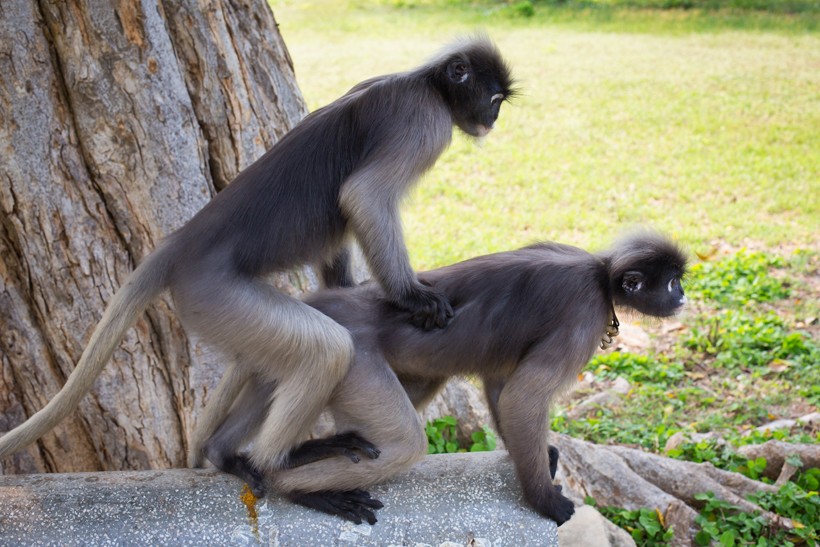
Only the large, aggressive and powerful male fertilizes the females.
?
Image credits: Palo_ok/Shutterstock
The mother provides the majority of parental care to the offspring. Various maternal behavioral patterns are displayed by the mother in the first 20 days after the birth of the offspring. These include scratching, kissing, grasping, leg pulling, and maternal grooming. These first 20 days the infant spends most of its time at the side of the mother.
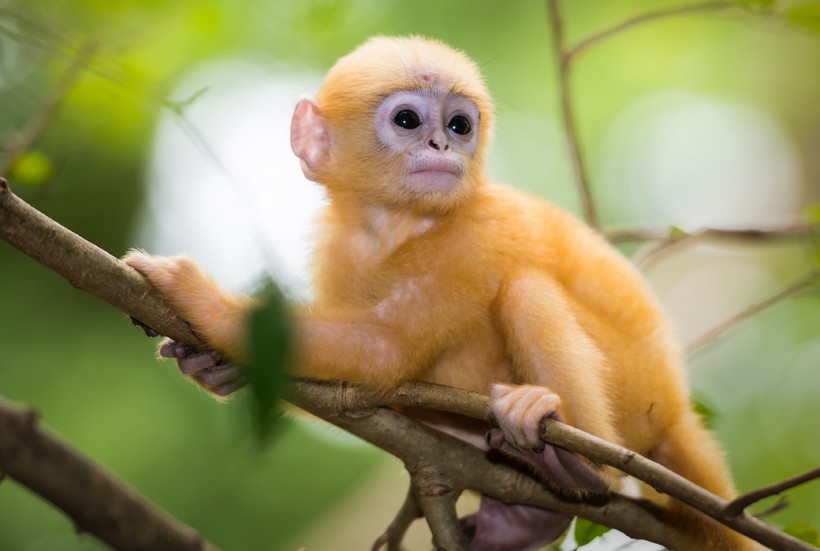
Within 6 months the color of the fur changes from orange to grey/brownish.
?
Image credits: tratong/Shutterstock
Infants start climbing and moving away from the mother once it turns one-year-old. At the same time, it starts also consuming solid food. In twenty days, the young one starts behavioral communication and self-playing. Self-playing usually involves jumping at the same place in series of 3-4 jumps. In the same time, the mother also exhibits repulsive behavior which includes biting, tongue flicking and pulling off from the nipple.
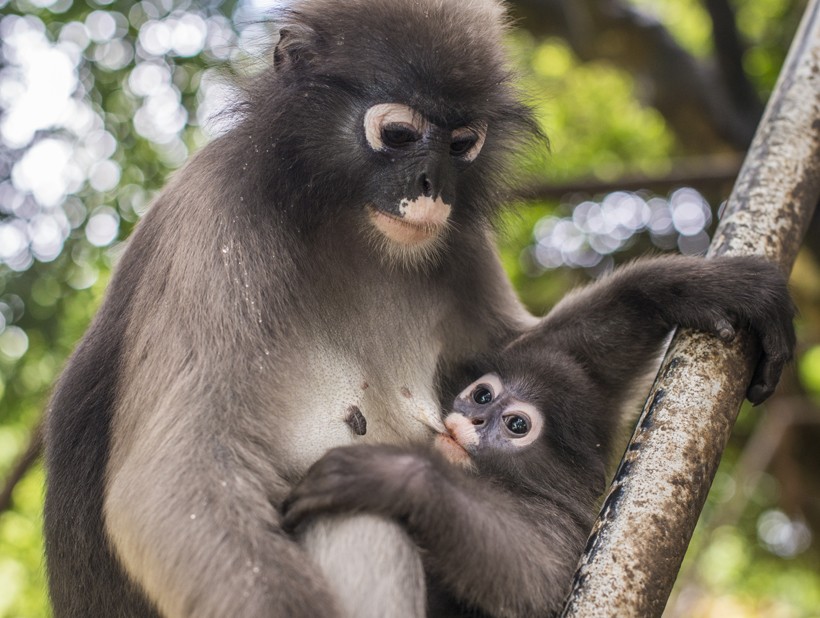
The newborn receives breastfeeding for about a year
?
Image credits: anucha maneechote/Shutterstock
In around 70 days from birth, the infant gets more socialized and mingles with other group members. Social play is observed around this time with other group members and in about 240 days the infant shows a complete distance from the mother. It presents to the adult male around this time.
Sub Species and Geographical Distribution
The Dusty Leaf Monkey has 7 sub species which show a difference in pelage colors, while the behavior and other aspects are similar.
- Trachypithecus obscurus obscurus
This subspecies of dusty leaf monkey has a pale tail and limbs and a brown to bronze colored pelage fur with a contrast color on the limbs and the tail. The crown patch on the posterior is creamy or yellowish-brown in color and the dorsal stripes are distinct. This subspecies is found on the Peninsular Malaysia, north of Perlis.
- Trachypithecus obscurus flavicuda
The T.o. flavicuda has a darker pelage than Trachypithecus obscurus obscurus and has a distinct brownish gray or creamy yellow colored limbs. A color variation is observed in this subspecies. This subspecies is found in northern Peninsular Malaysia, southwestern Thailand, and southern Myanmar which includes Kisseraing, James and King Islands in Mergui Archipelago.
- Trachypithecus obscurus halonifer
The subspecies of the dusky leaf monkey has a brownish body color with distinct formation of stripes on its dorsal side. The tail and limbs have a coloration that is similar to the body and the crown has a creamy white color. These subspecies are only found in Penang Island in Malaysia.
- Trachypithecus obscurus carbo
The T.o. carbo is very similar to Trachypithecus obscurus halonifer as far as the primer body color is concerned. The only difference is the slightly deeper and darker color of the dorsal stripes. This subspecies is found in Thailand and western coast of Malaysia. They are specifically located on Dayang Bunting and Terutao Islands in Thailand and Langkawi Island in Malaysia.
- Trachypithecus obscurus styx
This subspecies has a dark brown colored pelage all over the body and does not show any contrasting shade of colors on the tail and limbs. They consist of a buff colored crown and lack the presence of dorsal stripes. This subspecies can be seen on the East Perhentian Island and around eastern coastal Malaysia.
- Trachypithecus obscurus seimundi
This subspecies is similar to T.o. carbo and T.o. halonifer, in coloration of the body. It also consists of an additional frontal band in a browner shade of color. Limbs are faintly paler in comparison to the rest of the body. This subspecies can be found on Phangang Island in Thailand and also around eastern Thailand.
- Trachypithecus obscurus sanctorum
The obscurus sanctorum has a black colored body and a grayish yellow tail. The legs are dark gray with black feet, while the arms are black colored. The chest and posterior of this subspecies are creamy colored. This subspecies can be found on the Zadetkyi Kyun or the St. Mathew Island in Mergui Archipelago, Myanmar. This subspecies is restricted to this area only.
This subspecies of dusty leaf monkey has a pale tail and limbs and a brown to bronze colored pelage fur with a contrast color on the limbs and the tail. The crown patch on the posterior is creamy or yellowish-brown in color and the dorsal stripes are distinct. This subspecies is found on the Peninsular Malaysia, north of Perlis.
The T.o. flavicuda has a darker pelage than Trachypithecus obscurus obscurus and has a distinct brownish gray or creamy yellow colored limbs. A color variation is observed in this subspecies. This subspecies is found in northern Peninsular Malaysia, southwestern Thailand, and southern Myanmar which includes Kisseraing, James and King Islands in Mergui Archipelago.
The subspecies of the dusky leaf monkey has a brownish body color with distinct formation of stripes on its dorsal side. The tail and limbs have a coloration that is similar to the body and the crown has a creamy white color. These subspecies are only found in Penang Island in Malaysia.
The T.o. carbo is very similar to Trachypithecus obscurus halonifer as far as the primer body color is concerned. The only difference is the slightly deeper and darker color of the dorsal stripes. This subspecies is found in Thailand and western coast of Malaysia. They are specifically located on Dayang Bunting and Terutao Islands in Thailand and Langkawi Island in Malaysia.
This subspecies has a dark brown colored pelage all over the body and does not show any contrasting shade of colors on the tail and limbs. They consist of a buff colored crown and lack the presence of dorsal stripes. This subspecies can be seen on the East Perhentian Island and around eastern coastal Malaysia.
This subspecies is similar to T.o. carbo and T.o. halonifer, in coloration of the body. It also consists of an additional frontal band in a browner shade of color. Limbs are faintly paler in comparison to the rest of the body. This subspecies can be found on Phangang Island in Thailand and also around eastern Thailand.
The obscurus sanctorum has a black colored body and a grayish yellow tail. The legs are dark gray with black feet, while the arms are black colored. The chest and posterior of this subspecies are creamy colored. This subspecies can be found on the Zadetkyi Kyun or the St. Mathew Island in Mergui Archipelago, Myanmar. This subspecies is restricted to this area only.
Conservation Status & Ecological Importance
Not much information is available on the conservation status of the spectacled langur/dusky leaf monkey. The dusky leaf monkey has been categorized under near threatened by the Red list category and criteria. The locations of the species have shown extensive urbanization leading to a loss of habitat, resulting in a decline of the species. Currently, the population trend of the species is decreasing.
The majority of reasons for the noticed decline of this species includes loss of habitat, urbanization, and human interventions. The monkeys are also hunted down by humans for food.
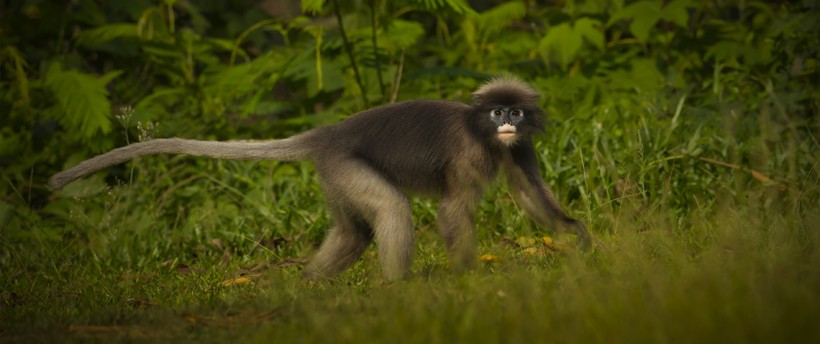
Extensive urbanization is leading to a loss of habitat
?
Image credits: Sainam51/Shutterstock
The species is recorded on CITES appendix II and is under protection in the areas of Taman Negara National Park in Malaysia, Khao Sok National Park, Taratau National Park in Thailand, Krau Wildlife Reserve, Kaeng Krachan National Park, and Khao Sam Roi Yot National Park. A survey on the current population is required to understand the exact status of the species.
The dusky leaf monkey plays a major role in the ecology of the forest. They are important for the dispersion of seeds as they thrive primarily on foliage. They also have an impact on the food chain as they serve as prey for various other species of animals.
Funfacts
- The name of the monkey includes “spectacled” which is adapted from the rings around the eyes which resemble spectacles or glasses.
- This monkey shows a close resemblance to humans. They have similar hands and feet with developed fingers and opposable thumbs.
- Both males and females look similar. They cannot easily be distinguished as they have similar morphological features.
- The newborns of these monkeys are colorful. The color of the fur is orange or bright yellow which changes to gray in six months’ time after birth.
- An alternative name for the dusky leaf monkey is the spectacled langur, wherein the word langur is derived from a Hindu word which means long-tailed.
